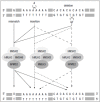Mismatch repair genes in Lynch syndrome: a review
- PMID: 19466295
- PMCID: PMC10969316
- DOI: 10.1590/s1516-31802009000100010
Mismatch repair genes in Lynch syndrome: a review
Abstract
Lynch syndrome represents 1-7% of all cases of colorectal cancer and is an autosomal-dominant inherited cancer predisposition syndrome caused by germline mutations in deoxyribonucleic acid (DNA) mismatch repair genes. Since the discovery of the major human genes with DNA mismatch repair function, mutations in five of them have been correlated with susceptibility to Lynch syndrome: mutS homolog 2 (MSH2); mutL homolog 1 (MLH1); mutS homolog 6 (MSH6); postmeiotic segregation increased 2 (PMS2); and postmeiotic segregation increased 1 (PMS1). It has been proposed that one additional mismatch repair gene, mutL homolog 3 (MLH3), also plays a role in Lynch syndrome predisposition, but the clinical significance of mutations in this gene is less clear. According to the InSiGHT database (International Society for Gastrointestinal Hereditary Tumors), approximately 500 different LS-associated mismatch repair gene mutations are known, primarily involving MLH1 (50%) and MSH2 (40%), while others account for 10%. Much progress has been made in understanding the molecular basis of Lynch Syndrome. Molecular characterization will be the most accurate way of defining Lynch syndrome and will provide predictive information of greater accuracy regarding the risks of colon and extracolonic cancer and enable optimal cancer surveillance regimens.
A síndrome de Lynch representa de 1-7% de todos os casos de câncer colorretal. É uma síndrome de herança autossômica dominante que predispõe ao câncer e é causada por mutações nos genes de reparo de ácido desoxirribonucléico (DNA). Desde a descoberta dos principais genes com função de reparo de DNA, mutações nos genes MSH2, MLH1, MSH6, PMS2 e PMS1 estão relacionadas com a susceptibilidade à síndrome de Lynch. Outro gene, MLH3, tem sido proposto como tendo papel na predisposição à síndrome de Lynch, porém mutações de significância clínica nesse gene não são claras. De acordo com o banco de dados InSiGHT (International Society for Gastrointestinal Hereditary Tumors), aproximadamente 500 diferentes mutações associadas à síndrome de Lynch são conhecidas, envolvendo primeiramente MLH1 (50%), MSH2 (40%) e outros (10%). Grandes progressos têm ocorrido para nosso entendimento das bases moleculares da síndrome de Lynch. A caracterização molecular será a forma mais precisa para definirmos a síndrome de Lynch e irá fornecer informações preditivas mais precisas sobre o risco de câncer colorretal e extra-colônico, além de permitir regimes otimizados de manejo.
Conflict of interest statement
Figures


References
-
- Lynch HT, Smyrk TC, Watson P, et al. Genetics, natural history, tumor spectrum, and pathology of hereditary nonpolyposis colorectal cancer: an update review. Gastroenterology. 1993;104(5):1535–1549. - PubMed
-
- Marra G, Boland CR. Hereditary nonpolyposis colorectal cancer: the syndrome, the genes, and historical perspectives. J Natl Cancer Inst. 1995;87(15):1114–1125. - PubMed
-
- Lynch HT, Smyrk T, Lynch J. An update of HNPCC (Lynch syndrome) Cancer Genet Cytogenet. 1997;93(1):84–99. - PubMed
-
- Lynch HT, Watson P, Kriegler M, et al. Differential diagnosis of hereditary nonpolyposis colorectal cancer (Lynch syndrome I and Lynch syndrome II) Dis Colon Rectum. 1988;31(5):372–377. - PubMed
Publication types
MeSH terms
LinkOut - more resources
Full Text Sources
Other Literature Sources
Research Materials
Miscellaneous

